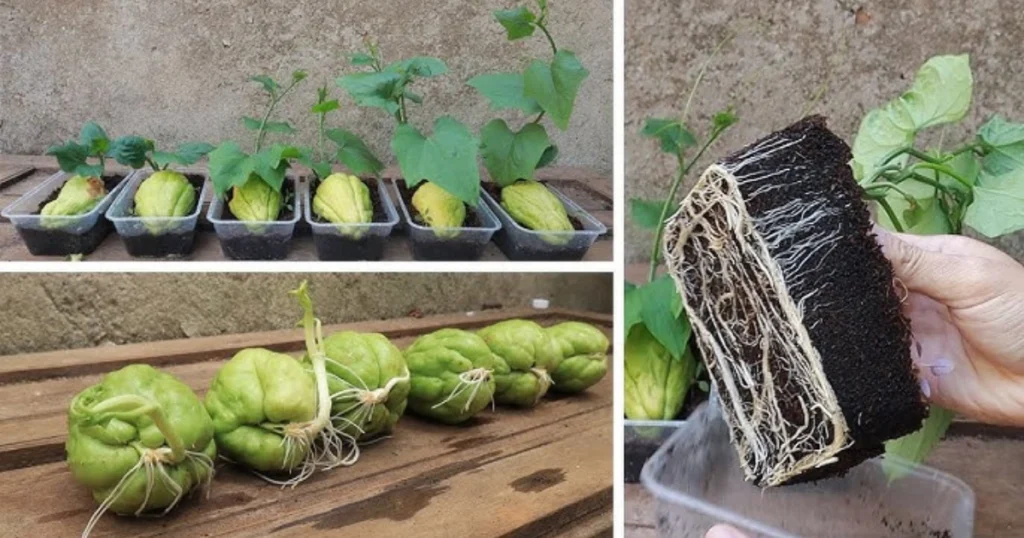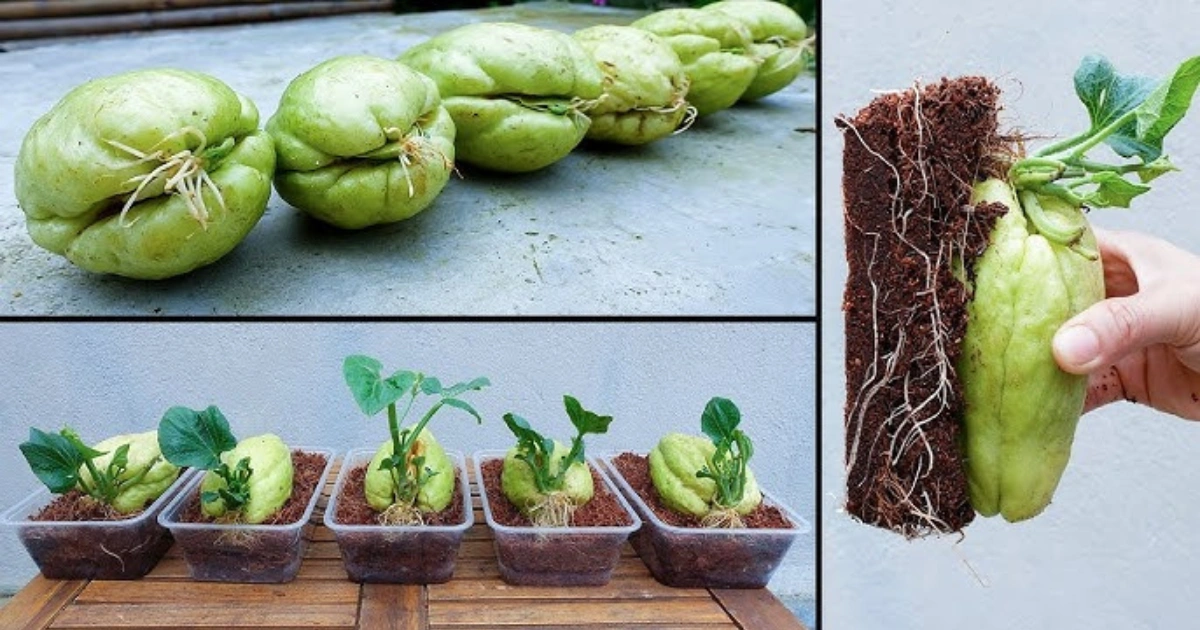If you’re looking to grow a highly productive, low-maintenance plant at home, chayote (also known as vegetable pear or mirliton) is a fantastic choice. With its fast-growing vines and nutritious fruits, this heat-loving vegetable is ideal for backyard gardens, balconies, or even large containers.
In this detailed guide, you’ll learn exactly how to grow chayote at home from a single fruit—no need for seeds. Whether you’re a beginner or a seasoned gardener, this simple method ensures a rewarding harvest in just a few months.

What Is Chayote?
Chayote (Sechium edule) is a perennial vine from the gourd family, native to Central America. It’s prized for its edible green fruits, which resemble wrinkled pears. The plant thrives in warm climates and is commonly used in soups, stews, and stir-fries due to its mild, crisp texture.
Step 1: Select a Mature Chayote Fruit
To start growing chayote, you’ll need a fully mature and healthy fruit. The skin should be green, firm, and free from blemishes or soft spots. Unlike many other vegetables, chayote doesn’t need to be cut or peeled before planting.
Let the fruit sit at room temperature until it naturally begins to sprout from the wider end. This may take a few days to a couple of weeks, depending on the temperature and humidity.
Step 2: Planting the Sprouted Fruit
Once your chayote has developed a visible shoot and some small roots, it’s ready to be planted.
- Container or soil: You can plant directly in the ground or in a large pot (minimum 20 liters).
- Position: Lay the entire fruit on its side in the soil, with the sprout facing upward.
- Soil requirements: Use well-draining, nutrient-rich soil. Compost-enriched loam or potting mix is ideal.
- Covering: Lightly cover the bottom half of the fruit with soil, leaving the sprout exposed to air and light.
Step 3: Caring for the Seedling
Chayote grows quickly and needs minimal effort once established.
- Watering: Water regularly to keep the soil moist, but avoid overwatering. The roots can rot in waterlogged soil.
- Sunlight: Choose a location with full sun to partial shade. At least 6 hours of direct sunlight is ideal.
- Support structure: Chayote is a climbing vine, so install a trellis, fence, or pole early on to support vertical growth and keep the fruit off the ground.
Step 4: Transplanting (If Needed)
If you started your plant in a small container or indoors, transplant it once the vine is at least 20–30 cm tall and has developed multiple leaves.
- Spacing: If planting in the garden, leave at least 1–1.5 meters between each plant to allow room for the vines to spread.
- Soil preparation: Add compost or well-rotted manure to the soil during transplanting to give your plant a nutrient boost.
Step 5: Harvesting Chayote
Chayote fruits typically mature in 3 to 4 months after planting, depending on the climate.
- Signs of maturity: Harvest when the fruits are firm, green, and roughly the size of your palm. Avoid letting them become too large, as the texture can become fibrous.
- Harvesting tip: Use pruning shears or a sharp knife to snip the fruit from the vine. Handle gently to avoid damaging the plant.
With good care, one plant can produce dozens of fruits throughout the season.
Pro Tips for Success
- Climate: Chayote thrives in warm, tropical, or subtropical conditions. If you live in a cooler region, grow the plant during summer or indoors with sufficient light.
- Fertilization: Apply a balanced organic fertilizer every 3–4 weeks during the growing season.
- Pest control: Monitor for aphids and whiteflies. Neem oil or insecticidal soap works well for natural pest management.
- Multipurpose use: Beyond the fruit, chayote leaves and tender shoots are also edible and used in stir-fries and herbal teas.
FAQs About Growing Chayote at Home
Can chayote grow in pots?
Yes, chayote grows well in large containers as long as the pot provides enough space for root expansion and climbing support.
How long does chayote take to grow?
Chayote usually takes 90 to 120 days to reach full maturity after planting, depending on climate and care.
Does chayote come back every year?
In warm climates, chayote behaves as a perennial and can regrow each year from the same rootstock. In colder climates, it is often grown as an annual.
Can I grow chayote indoors?
Yes, chayote can be grown indoors near a sunny window or under grow lights, especially in colder regions. However, you’ll still need a trellis or support structure.
Is chayote fruit or vegetable?
Botanically, chayote is a fruit, but it is typically used as a vegetable in savory dishes.
Internal Article Suggestions from secretsofthegreengarden.com
- How to Make Organic Liquid Fertilizer at Home
- Beginner’s Guide to Balcony Gardening
- Top 10 Heat-Tolerant Vegetables for Summer Growing
External Resource Suggestions
- University of Florida Gardening Solutions – Chayote
- NC State Extension – Growing Chayote
- Gardener’s Path – How to Grow Chayote Squash
Summary
- Main keyword: grow chayote at home
- LSI/NLP keywords used: planting chayote, chayote vine, tropical vegetables, home gardening, edible vines, trellis plants, sprouting chayote, chayote care, vegetable pear
- Internal link suggestions:
- How to Make Organic Liquid Fertilizer at Home
- Beginner’s Guide to Balcony Gardening
- Top 10 Heat-Tolerant Vegetables for Summer Growing
- External links:


u4z0ec
**mind vault**
mind vault is a premium cognitive support formula created for adults 45+. It’s thoughtfully designed to help maintain clear thinking
https://t.me/site_official_1win/600
https://t.me/s/iGaming_live/4864
https://t.me/s/officials_pokerdom/3659
برای دوستانی که به دنبال یک راهکار مطمئن برای وریفای حساب در بروکرهای فارکس هستند، پیشنهاد میکنم خدمات شوپی را بررسی کنند. این مجموعه به صورت تخصصی، وریفای قانونی حساب های فارکس را با مدارکی ارائه میدهد که کاملاً معتبر بوده و به نام خودتان صادر میشود. این روش دائمی است و ریسک بلاک شدن حساب شما را به صفر میرساند. کیفیت و پشتیبانیشان واقعاً عالی است.
https://t.me/s/be_1win/970
از سرعت کار گرافیسو واقعاً خوشم اومد. بعد از ثبت سفارش، فایل گواهینامه رانندگی کانادا همون روز ارسال شد و نسخه فیزیکی هم خیلی شکیل بستهبندی شده بود. پیشنهاد میکنم حتماً از خدمات گواهینامه رانندگی کانادا استفاده کنید، چون هم کیفیت کار بالا و هم پشتیبانی فوقالعادهای داره.